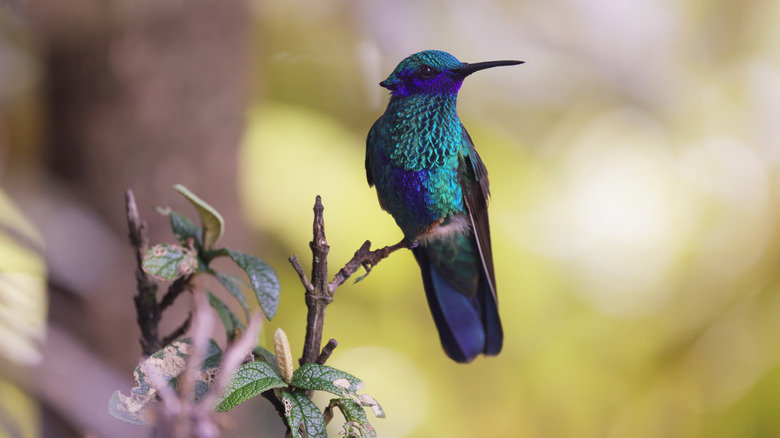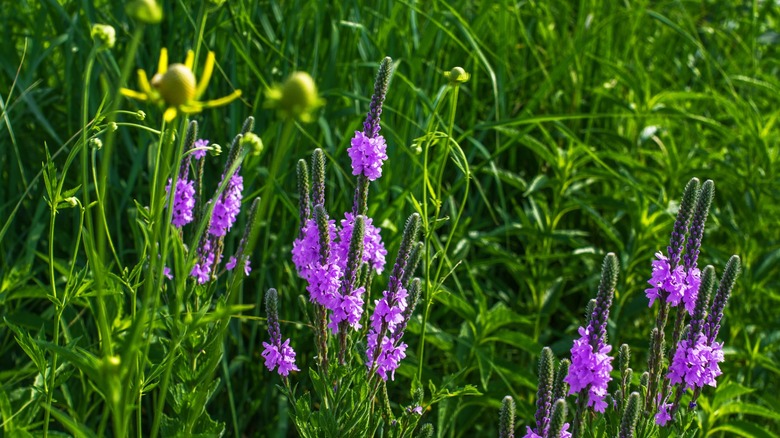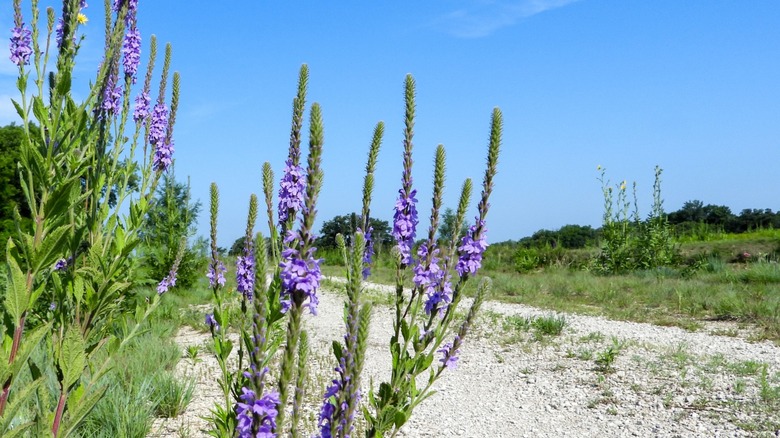The Self-Seeding Flower That'll Keep Hummingbirds Coming To Your Yard Year After Year
Curating the garden of your dreams is actually more straightforward than you think. All it really comes down to is selecting the best gardening methods and the right plants. While that might sound basic, it's really that simple. Let's say you want your garden to stay colorful all year, mix and match different summer perennials that take turns blooming. If you want fewer pests, grow herbs and flowers that naturally repel them. And if you want pollinators always buzzing around, fill your yard with the kind of plants they actually want.
The thing is all pollinators, like people, have their preferences. Hummingbirds, for example, are drawn to tubular, nectar-rich flowers, especially in red, pink, or purple shades, and hoary vervain (Verbena stricta) is one native wildflower that fits the bill perfectly with its upright purple blooms. On top of that, it's the kind of plant that keeps flowering long after other plants in your garden have faded, so it guarantees you a steady supply of nectar deep into the season.
What's more, it's just as attractive to bees and butterflies as it is to hummingbirds. So, that makes it a great choice if your overall goal is to achieve a pollinator-friendly garden. And the best part is that once hoary vervain establishes itself in the garden, it reseeds itself. So, that means you won't need to worry about replanting. As long as the conditions are right, it'll keep returning, season after season, without you having to do so much.
What makes hoary vervain remarkable?
First of all, this is a good-looking bloomer with upright, pencil-thin flower spikes and gray-green, hairy foliage that grows in clumps 2 to 4 feet tall. However, beyond how pretty it looks, it's a plant that gives and gives, attracting pollinators and beautifying your space, year after year, while asking for very little in return. Its name, hoary, comes from the fine grayish hairs that cover its stems and leaves. These hairs aren't merely decorative; they help the plant conserve moisture, helping it survive in drought-prone environments. That's why it's particularly easy to find in open prairies, dry fields, and roadside shoulders across the central and eastern parts of the United States.
Hoary vervain is hardy in USDA Zones 4 through 8 and is often included in prairie and savanna seed mixes, especially for habitat restoration projects. It's a dependable species for establishing biodiversity in dry grassland environments. Beyond its role as a nectar source, its seeds feed small mammals and birds like juncos and sparrows. Its foliage also serves as a larval host for butterflies.
Historically, like other vervains, this species was part of folk remedies. Herbalists once used infusions of the leaves as a tea to help with fevers and upset stomachs. That's not a common application these days. People don't grow it for food or medicine anymore. Even though it's not the most popular wildflower out there, it's a rather efficient choice for anyone who wants to invite hummingbirds to their yard.
How to plant and care for hoary vervain
Hoary vervain is easy to grow. You don't need to fertilize it too much, water it so often (unless it's unusually dry), or fuss over it really. If it gets too much water, the roots could rot. What it does need is good drainage and full sun. While it can tolerate partial shade, it really thrives when it gets at least six hours of direct sunlight a day. That makes it perfect for borders, meadows, xeriscapes, and even neglected corners of your yard.
Because it's a drought-tolerant plant capable of growing in poor soil, you can plant it in places where more delicate ornamentals would struggle. It's also deer-resistant, which helps if wildlife is a recurring challenge in your garden. And even though it self-seeds prolifically, it doesn't spread aggressively. You'll see more of it return each year, but not in an invasive way.
However, to encourage reseeding, let the plant bloom fully and go to seed before trimming anything back. Once the seeds mature and fall to the ground, they'll begin sprouting in spring with very little help. And if you want to create a pollinator haven that keeps hummingbirds circling your yard, consider pairing hoary vervain with black-eyed Susan (Rudbeckia hirta) for a vibrant contrast of purple and gold. It also pairs beautifully with yellow coneflower (Echinacea paradoxa) and bee balm (Monarda spp.), two other favorites that bloom around the same time and attract hummingbirds.


